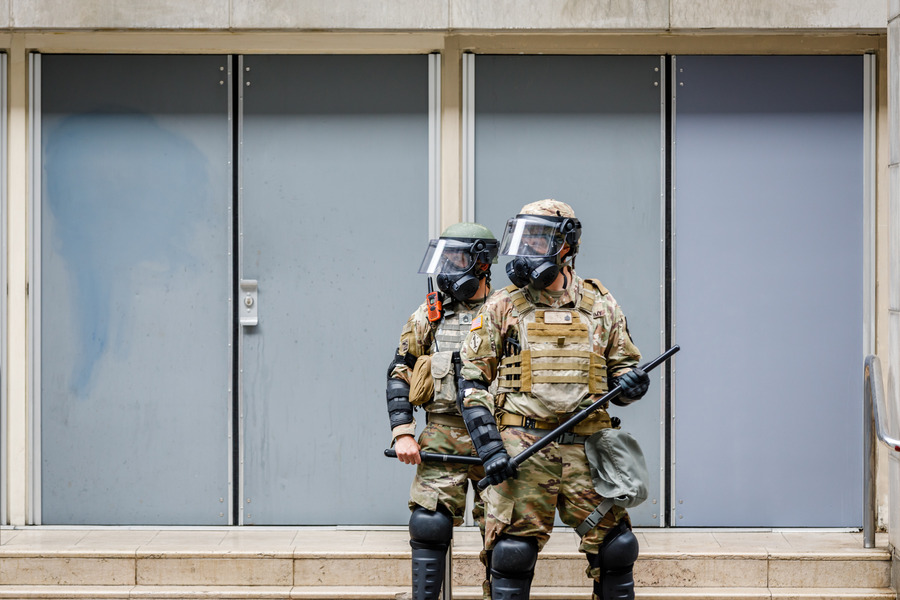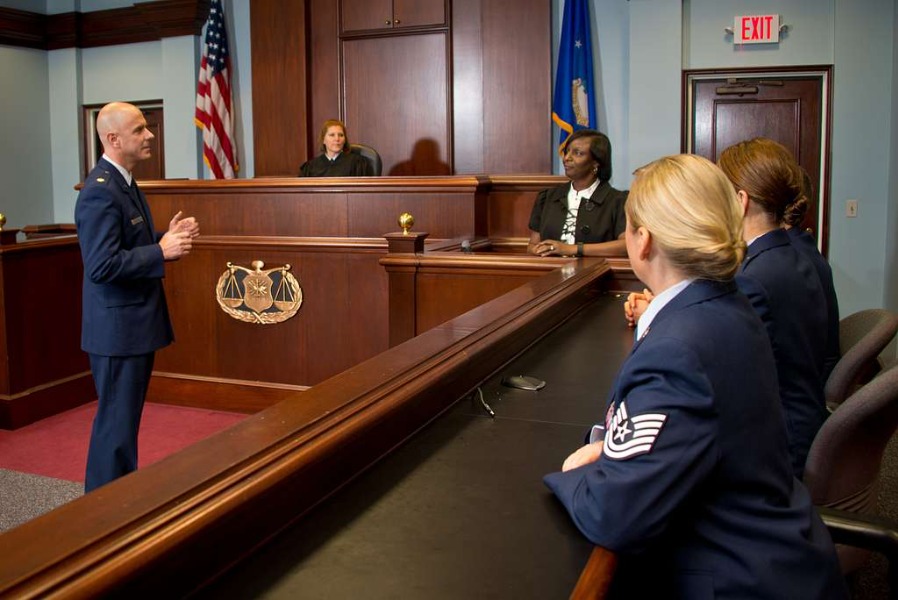How the Insurrection Act (Properly Understood) Limits Domestic Deployments of the U.S. Military

Published by The Lawfare Institute
in Cooperation With

Editor’s note: This essay is part of a series on the limitations, drawbacks, and dangers of domestic deployments, from Lawfare and Protect Democracy.
The U.S. Constitution gives the president broad power both to direct the world’s largest military and to protect national security more generally. But, although executive power over national security has expanded in recent decades—under both Democratic and Republican administrations—U.S. law generally forbids the president from deploying military forces within the United States, outside the context of invasion or rebellion.
The Insurrection Act is an important exception. Although little-known and (fortunately) used sparingly, the act gives the president potentially broad authority to use the military to protect the country from threats inside the United States. While such a power can be crucial in times of genuine crisis, it also poses a serious risk of abuse. For example, former President Trump has suggested that, if elected, he would invoke the Insurrection Act and deploy the military to quell protests around the country, provide security at the southern border, and aid in deporting noncitizens. Democratic presidents too might be tempted to use the Insurrection Act against perceived domestic threats.
Unfortunately, the language of the act is vague and overbroad, and many experts from across the political spectrum have rightly called on Congress to revise the text. In an article forthcoming in the Harvard National Security Journal, I survey these proposed legislative reforms and argue in favor of many of them (along with reforms to other areas of the U.S. national security legal framework).
But even without amendments to the act, the statutory text, as it stands, can and should be read narrowly, for both constitutional and practical reasons. Indeed, executive branch officials themselves have long argued, in a variety of contexts, that the act must be understood to be limited in scope if it is to conform to the constitutional scheme. Practical concerns are also likely to arise if a president were to invoke the act, concerns that surfaced during a recent series of national security scenario planning exercises in which I participated. Run by the Brennan Center for Justice this summer, the “Democracy Futures Project” convened bipartisan groups of former senior government officials and other experts to game out the consequences if a future president attempted to use the Insurrection Act. Perhaps unsurprisingly, those consequences were disturbing for anyone interested in the future of democratic government.
Overbroad Statutory Text
Although the Posse Comitatus Act generally bars federal military personnel from engaging in civilian law enforcement operations, the Insurrection Act, first adopted in 1792 and amended multiple times since, now functions as a key exception to this rule by allowing the president to deploy U.S. armed forces domestically to address civil unrest or enforce the law in a crisis. And while the Insurrection Act is not the only federal statute that might be used to justify domestic use of the military, it is undoubtedly the most important. Insurrection Act authority has enabled the president to quell significant domestic conflicts, for example, to address racial violence perpetrated by the Ku Klux Klan after the Civil War or to enforce court orders desegregating schools over the objection of local officials.
As currently drafted, the act authorizes the president to deploy the U.S. armed forces, federalize the National Guard, or deputize private militias in three types of circumstances.
The first and most limited path is Section 251, which allows the president to deploy troops if a state’s legislature (or governor if the legislature is unavailable) requests federal assistance to suppress an “insurrection” within that state. This provision requires direct involvement from state-level authorities and is limited to outright “insurrection,” making it somewhat less susceptible to presidential abuse.
The second trigger, Section 252, grants the president more discretion because it does not require the request of state officials and is broader in scope. Specifically, this section permits the president to deploy the military if the president “considers that unlawful obstructions, combinations, or assemblages, or rebellion against the authority of the United States, make it impracticable to enforce the laws of the United States in any State by the ordinary course of judicial proceedings.” In interpreting a precursor to the Insurrection Act, in the case of Martin v. Mott, the Supreme Court suggested that the president has relatively broad discretion to interpret the act’s statutory language. Nonetheless, the statutory text itself suggests that the president may rely on this provision only in extreme circumstances, such as a condition of war or a serious disruption of civilian affairs.
Perhaps the most concerning provision is Section 253, which allows the president to act if the president deems it “necessary to suppress, in a State, any insurrection, domestic violence, unlawful combination, or conspiracy” if it “(i) so hinders the execution of the laws of that State, and of the United States within the State, that any part or class of its people is deprived of a right, privilege, immunity, or protection named in the Constitution … and the constituted authorities of that State are unable, fail, or refuse to protect” the above; or “(ii) opposes or obstructs the execution of the laws of the United States or impedes the course of justice under those laws.” Congress added this subsection after the Civil War to address widespread violence and attacks on the Black population led by the Ku Klux Klan. But it is particularly broad and vague, and could in theory encompass even relatively minor obstructions to the “execution of the laws” of the United States or impediments to “the course of justice” under those laws, such as a small protest interfering with law enforcement activities or judicial proceedings, so long as there were a conspiracy to do so by two or more persons. (It is worth noting, however, that even this seemingly broad language would appear to require some obstruction of law enforcement and is focused on violations of federal, rather than state, law.)
Under this third trigger, the potential means of force allowed are also apparently quite broad. The statute allows the president to respond “by using the militia or the armed forces, or both, or by any other means.” Thus, the provision permits not only the use of the armed forces and the National Guard but also private militias, currently defined by Congress to include “all able-bodied males at least 17 years of age and … under 45 years of age who are, or who have made a declaration of intention to become, citizens of the United States, and female citizens of the United States who are members of the National Guard.” The “any other means” language is also obviously both sweeping and vague.
Crucially, neither Section 252 nor 253 requires any request or approval from state authorities before the president can act. This means the president could theoretically invoke these provisions to send in the military even against the will of state and local governmental officials. Section 251 has been used on a number of occasions to send armed forces to help address labor disputes, racial unrest, and looting in response to national disasters, after requests from state governments to do so. But the other sections of the act, though broadly worded, have been invoked sparingly. Most famously, Presidents Dwight D. Eisenhower, John F. Kennedy, and Lyndon Johnson relied on Section 253 to desegregate schools in the South and protect civil rights marchers in the face of opposition by state governors. In those cases, however, Section 253 was used in a limited fashion only to enforce federal court orders. Overall, the Brennan Center for Justice has identified only 30 crises in which the statute has been used over the course of 230 years.
Yet the Insurrection Act’s expansive language, particularly in Section 253, leaves it vulnerable to abuse, prompting growing calls from legal scholars and commentators for Congress to reform the law and impose tighter constraints on the president’s ability to invoke it. Experts across the political spectrum, including Bob Bauer and Jack Goldsmith, the Brennan Center for Justice (primarily through the work of Elizabeth Goitein and Joseph Nunn), the Cato Institute, the American Law Institute, Harold Koh, Mark Nevitt, and William Banks, have put forward reform proposals. These proposals include adding more specific, substantive limits on the circumstances in which the president can deploy the military domestically; eliminating references to private militias; and adding more robust procedures to ensure transparency, set time limits without explicit congressional authorization, require the concurrence of military and local officials, and allow judicial review. Although some reforms have been introduced in Congress, none has been enacted.
Arguments That the Current Text of the Act Should Be Interpreted Narrowly
While legislative reforms would be helpful, a strong case can be made that the existing language of the Insurrection Act should be read narrowly, for both constitutional and practical reasons. In fact, U.S. executive branch lawyers have long made arguments along these lines. As a 1964 Department of Justice Office of Legal Counsel (OLC) memo put it, although the provisions of the act may “appear on their face to confer broad authority to use troops to enforce federal law generally, whenever the President deems it necessary,” they are nonetheless “limited … by the Constitution and by tradition.” In another example, a 1975 Justice Department memo observed that these provisions should be invoked only as a “last resort,” language that can also be found in the 1964 memo. More recently, during the Trump administration, Attorney General William Barr advised against the use of the act to respond to protests that erupted after the death of George Floyd. And in the same context, Gen. Mark Milley, chairman of the Joint Chiefs of Staff, reportedly “recoiled at the idea” of deploying the military under the act and, using language echoing the memos described above, argued that the act should be invoked only as a “last resort,” conditions that he urged were not present at that time.
The Constitutional Backdrop
Digging a little bit deeper into these memos, a key argument emerges: The Insurrection Act must be read against the backdrop of three different constitutional provisions—the 14th Amendment, the Supremacy Clause, and Article IV, Section 4. In light of these provisions, the executive branch memos argue that the discretion contained in the Insurrection Act should be understood narrowly, so the statute is used only as a “last resort,” when, as the 1964 memo puts it, “state and local law enforcement ha[s] completely broken down,” or to enforce a court order that state or local officials refuse to enforce.
14th Amendment
Though Section 253 is perhaps the most troubling part of the Insurrection Act because of its seemingly broad language, it is important to recognize that Congress enacted this section in the aftermath of the Civil War pursuant to its authority under the 14th Amendment. Specifically, Congress acted to allow the president to deploy the military to protect against violence perpetrated by the Ku Klux Klan. OLC has argued, therefore, that Section 253 contains inherent limits because the 14th Amendment requires state action. Accordingly, OLC has concluded that, absent a court order, the statutory language authorizing the president to act unilaterally without a request from the state must be interpreted to require, as a “prerequisite,” that “state authorities are either directly involved, by acting or failing to act, in denials of federal rights,” or that state authorities “are so helpless in the face of private violence that the private activity has taken on the character of state action.” Based on this interpretation, Section 253 could not be used in response to more ordinary protest activity by private parties or to address federal law enforcement matters, such as deportations.
Supremacy Clause
When the president unilaterally invokes the Insurrection Act to enforce a court order that state or local officials refuse to enforce, such action is less controversial and can be justified under the Supremacy Clause (or, as suggested in a 1957 OLC opinion, under the president’s inherent authority to compel obedience to the law). As the 1964 OLC opinion notes:
The degree of breakdown in state authority that is required undoubtedly is less where a federal court order is involved, for there the power of the federal government is asserted not simply to enforce the Fourteenth Amendment, but to defend the authority and integrity of the federal courts under the Supremacy Clause of the Constitution.
According to OLC, the flip side of such Supremacy Clause authority, however, is that without an actual court order to enforce, along with the refusal of state or local officials to follow such an order, “the situation must be one which, in the judgment of the President, involves a serious and general breakdown of the authority of state and local government in the area affected.” Again, more ordinary protest activities would not be sufficient to justify invoking the act, nor likely would general immigration enforcement.
Article IV, Section 4
Finally, Article IV, Section 4, of the Constitution obliges the federal government to protect a state against “domestic violence” on “Application of the Legislature, or of the Executive (when the Legislature cannot be convened).” As noted in the 1975 Justice Department memo, “this is the basis for intervention by federal troops or marshals in civil disorders occurring within the states.” Law professor William Banks has argued, however, that the “domestic violence” language in the clause means that the president could not invoke any provision of the Insurrection Act unless this standard were met. The 1975 Justice Department memo does not make this argument explicitly, but it does cite Article IV, Section 4 and states that the president should invoke the act only as a “last resort.”
Other Constitutional Provisions
Although not the focus of the Justice Department opinions, the Fourth Amendment and First Amendment to the Constitution would apply to any domestic deployment of the military under the Insurrection Act. These provisions would set limits on the use of force and provide protections for peaceful protest activity.
Practical Concerns
A president’s decision to invoke the Insurrection Act, in particular under Sections 252 and 253 without the request of a state, also raises a host of practical concerns that should counsel in favor of a narrow interpretation of the statute. U.S. executive branch officials have long highlighted such concerns, and many became evident during the Brennan Center planning exercises. Two of these exercises focused specifically on the domestic use of the military, in one case to assist at the southern border and with immigration enforcement, and in another to crack down on protests. In both scenarios, the president invoked the act to deploy U.S. armed forces and to federalize the National Guard without the consent of state officials, and in one case the president chose to deputize private militias as well.
Lack of Training
As noted by OLC in 1964, U.S. forces when deployed domestically may be asked to engage in “routine law enforcement functions” for which they have “little training.” Lack of training likewise proved to be a big concern that those playing the role of federal military officials raised in the scenario planning exercises. They emphasized that the U.S. armed forces are not well prepared to engage in domestic law enforcement activities, and National Guard training may be uneven. The U.S. Army recently updated its Domestic Operational Law , which includes rules and policies for domestic deployments. And the National Guard units assigned to a civil disturbance mission are required to conduct annual training. Nonetheless, the military, including the National Guard, generally receives more extensive instruction for overseas deployments. Overseas deployments are typically governed by international humanitarian law and related use of force rules, which are in most cases more permissive than the rules applicable to law enforcement activities. Due to the lack of preparation, military forces acting on U.S. soil may be at risk of exceeding the legal limits on the use of force and infringing on individuals’ constitutional rights, for example, under the Fourth and First Amendments as noted above. And the armed forces themselves could find these risks demoralizing.
In the scenario planning exercises, the lack of training for deputized private militias was a particular problem that led to abuse of force and general chaos.
Coordination Challenges
The invocation of the Insurrection Act, particularly without the consent of state officials, also presents serious coordination challenges, raising questions about how responsibilities are to be divided among federal, state, and local officials. In the scenario planning exercises, the coordination challenges were especially problematic when the president deputized private militias. For example, in one scenario, private militia members shot at protesters, including religious protesters, and did not follow orders from military officials. Even red state governors and other state officials in the scenario strongly objected to private militias operating in their states at all.
Risk of Alienation of State and Local Officials
Finally, OLC has raised the concern that, if forces are deployed under the authority of the Insurrection Act, it can “become[] difficult to find a way to withdraw.” This is because, once the act is invoked without the consent of state officials, “[l]ocal authorities tend to abdicate all law enforcement responsibility, leaving the troops without adequate tools—short of a declaration of martial law—to perform routine law enforcement functions.” The 1964 OLC memo also notes that, if the forces go beyond the investigation and prosecution of federal crimes, their presence may “serve[] to aggravate the emotions of the populace or alienate local law enforcement officials.”
***
The Insurrection Act, if deployed without restraint, could ultimately transform a constitutional democracy into a police state patrolled by the U.S. military. To protect against such potential overreach, Congress should revise the statute, and commenters across the political spectrum have already put numerous useful reforms on the table. But even absent statutory reforms, the executive branch and the courts can and should follow long-standing Justice Department guidance and interpret the current text of the Insurrection Act narrowly, both so that the act will conform to our constitutional scheme and so that we can avoid the many practical problems that likely would accompany an insufficiently justified invocation of the act.





